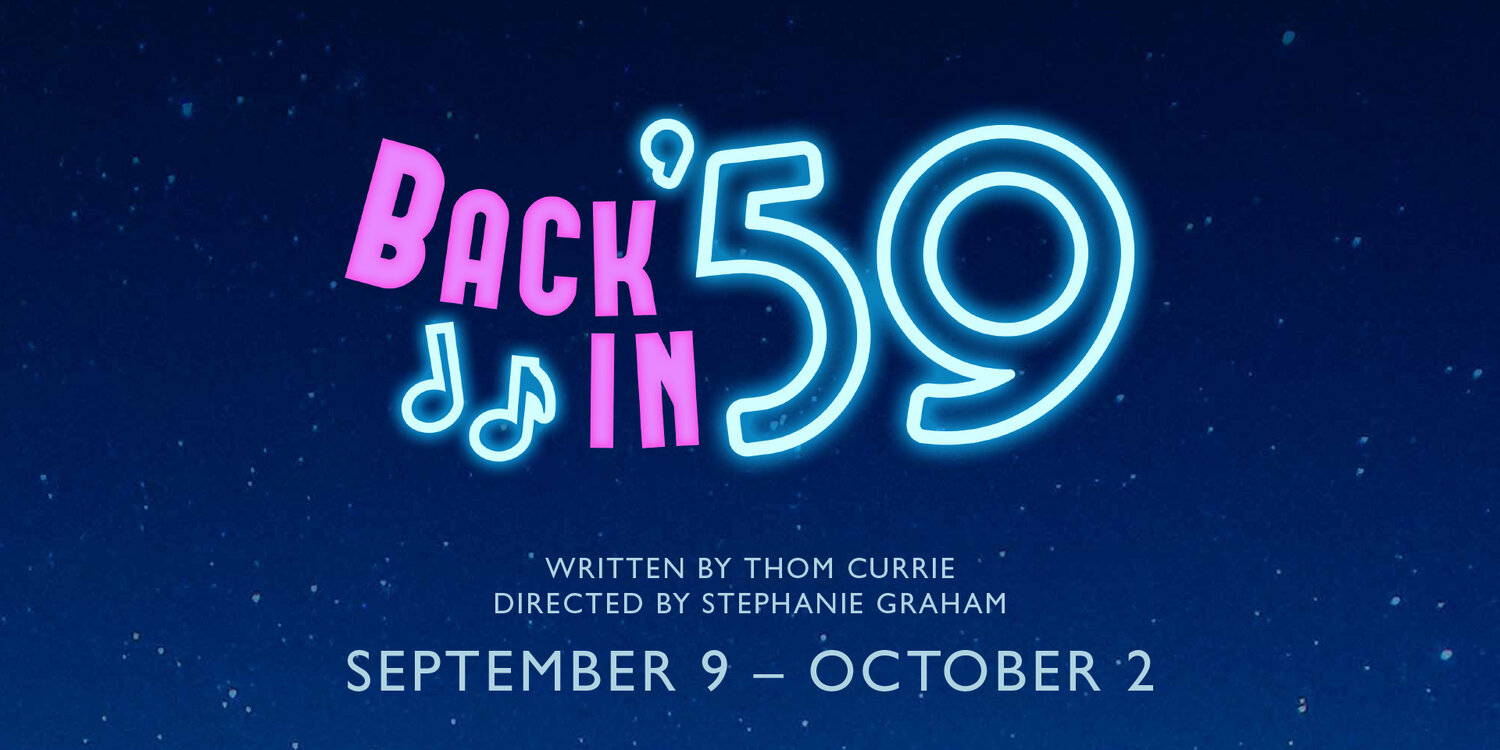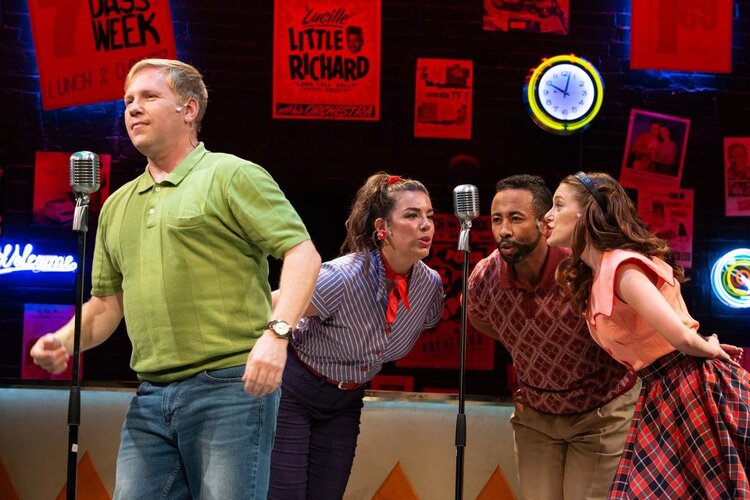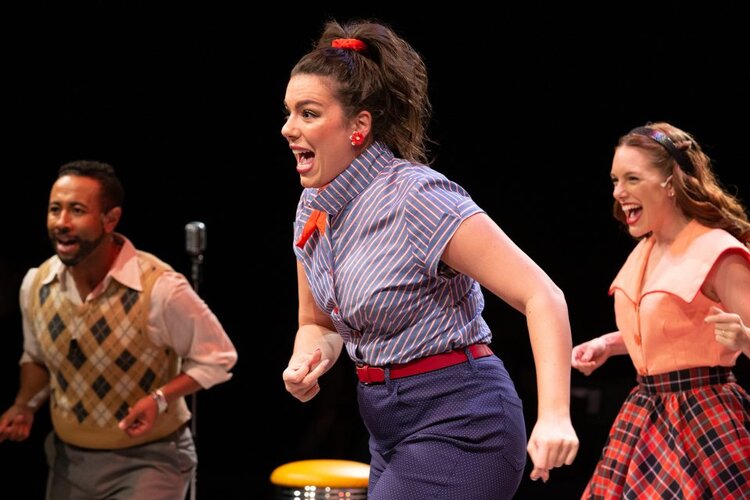Back In ’59: Fun and Fancy Free?

It was a rainy Wednesday afternoon when I asked my father to join me for some caramel corn and a matinee performance of Thom Currie’s Back in ’59, the Thousand Islands Playhouse show that is Mashed Potato-ing its way through a sold-out run (or in our case, available via streaming online).
Despite not being present for all the toe-tapping and in-seat jiving I’m sure accompanies the live productions, we found ourselves enjoying the music and even politely clapping at the television after the more vivacious musical numbers.
At the end of the performance, my father (ever the diplomat) summed up his thoughts into one brief statement: “If you enjoy the music of the ‘50s, then you will enjoy this show.” (I would amend this to include enjoying complex harmonies and iconic dances of the ‘50s that the four leads make look easy.)

While this tagline does create a workable theory for audience enjoyment, I wonder what else it implies. This performance of Back in ’59 does not exist in a vacuum. On the contrary, it’s being produced by one of the biggest theatre companies in Eastern Ontario, following a substantial hiatus. After discussing the makeup of the piece, I will consider the production of Back to ’59 within the context of 2021. And to my father who says that I dig too deep into these things, I’ll say, “it’s my review, and I’ll pry if I want to.”
Set in 1973, Back in ’59 follows four friends who decide to ditch their tenth high school reunion in an act of rebellion and musical reminiscence. Drawing on their years spent as a dynamic cover group, the characters recount their past as well as the radio hits from 1959-1964. Through various mashups and lighthearted conflict, we begin to learn more about them as well as the times they are living through.
While the plot swims more towards the shallow end of the pool (the largest conflict being whether or not it was okay for her to ask him on a date), the actors performing it do so seamlessly. Director and choreographer Stephanie Graham notes in a pre-show interview her research into the specific dances necessary to convey the ‘50s and ‘60s zeitgeist—and the work shows. Performers Justine Lewis, Julia McLellan, Jeremy Carver-James, and Andrew Hodwitz combine this knowledge with their musical prowess and utmost energy for a product that probably very well resembles the music-filled television shows of the early 1960s.
But whether it does or doesn’t accurately strike that resemblance is hard for me to say, because the time period in question was 37 years before I was born. Even my father admitted to being at a loss for nostalgia, with the majority of pre-70s music populating his childhood coming from Irish folk music, rather than American television.

Where then does Back in ’59 sit in a contemporary context? In her Director’s Note, Graham writes:
“Through the last seventeen months I have always believed that we will need all types of theatre coming out [of] the pandemic. There is space for stories that deal with grief, there is space for stories that encourage us to take action, and there is space for stories that celebrate joy. Back in ’59 is ninety minutes of song, dance and joy! Welcome back to the theatre.”
While she is certainly correct in the piece’s makeup, I wonder what joy, or rather whose joy Graham is referring to. The delineation between grief, action, and joy is also a bit of a monotonous restriction to put on any theatre piece, as many shows successfully create the space with which to discuss all three themes, and more. My father and I certainly found joy in the bright visuals and tight musical renditions, but in lacking the nostalgic background apparently necessary, it could only be called transitory.
Furthermore, while nostalgia certainly has a place in evoking specific emotions (or getting bums in seats), it is also subject to specific drawbacks. For example, in addition to the show combining a medley of chart-topping tunes from 1959-1964, it also illuminates the heteronormative, patriarchal values that were present during the times. In a particularly snappy number, the group sings of ‘The Book of Love’:
Chapter One says to love her, you love her with all your heart Chapter Two you tell her you’re never, never, never, never, ever gonna part In Chapter Three remember the meaning of romance In Chapter Four you break up, but you give her just one more chance
— (Who Wrote) The Book of Love by The Monotones
As a Queer person, all I can say is thank goodness the book has been updated since the 1950’s (or perhaps tossed out altogether). From an audience perspective, I wonder how many of these zeitgeist songs one can hear before subconsciously believing them, or finding a questionable affirmation. As for the characters, although they are intermittently critical of the music of their high school years, the 8-minute mashups that follow their considerations suggest otherwise.
In considering all of this, I don’t wish to denounce anyone’s enjoyment of the piece or discredit the rigorous efforts of the cast and production team. I want to pose a question of why here, why now, and for whom? As the Thousand Island Playhouse’s two returning pieces Back in ’59 and Sexy Laundry have both garnered sold out runs, audience members might begin to ask, what sort of joy is being curated? What grief? Which calls to action?
And above all, as we begin to gather again in places of live art, will it be to escape the pressing questions intensified by a global pandemic, or to try and grapple with them?
In his Letter from the Managing Artistic Director, Brett Christopher states the playhouse’s 2021 season intentions of a gentle re-entry into the act of gathering together. While I certainly cannot call myself versed in the financial undertakings of a regional theatre nor the risks that go into season planning, I can only wonder what this gentle re-entry implies, and what is to come.
As I ponder this, I munch on the last bits of caramel corn; and though it is bright and tasty, I know that I will likely be feeling hungry again in a short while.
Back in ’59 is sold out at Thousand Islands Playhouse, and was available for select online performances. Check out what’s to come from their 2021 season here.
